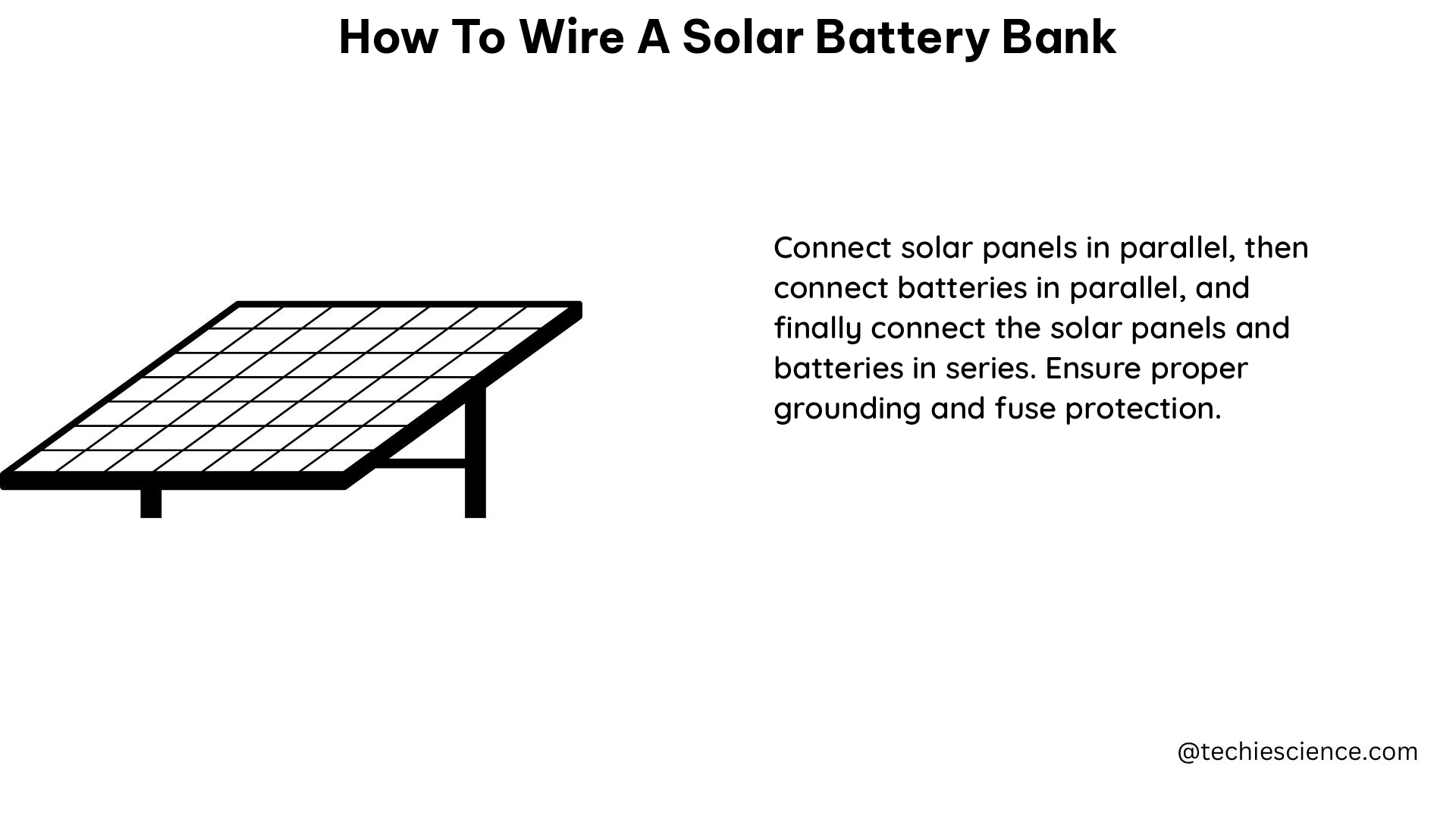Wiring a solar battery bank is a crucial step in setting up an off-grid or hybrid solar power system. This comprehensive guide will provide you with the technical details and step-by-step instructions to ensure your solar battery bank is wired correctly and efficiently.
Battery Type Considerations
The type of battery you choose for your solar battery bank will significantly impact the wiring configuration. Here are some key considerations:
- Lithium-ion Batteries: These batteries typically have a higher voltage (around 3.6V per cell) compared to lead-acid batteries (around 2V per cell). This means you may need to wire them differently to achieve the desired voltage and current output.
- Lead-acid Batteries: These are the most common type of batteries used in solar battery banks. They come in various subtypes, such as flooded, sealed, and gel, each with its own wiring requirements.
- Capacity and Voltage: The capacity (in Amp-hours) and voltage (in Volts) of the batteries will determine the overall capacity and voltage of your solar battery bank.
Wiring Configurations

The wiring configuration of your solar battery bank will affect the voltage and current output. Here are the three main wiring configurations:
- Series Wiring: In this configuration, the positive terminal of one battery is connected to the negative terminal of the next battery. This increases the overall voltage of the battery bank, while the current remains the same as a single battery.
- Example: Four 12V, 100Ah batteries wired in series will create a 48V, 100Ah battery bank.
- Parallel Wiring: In this configuration, the positive terminals of the batteries are connected together, and the negative terminals are connected together. This increases the overall capacity of the battery bank, while the voltage remains the same as a single battery.
- Example: Four 12V, 100Ah batteries wired in parallel will create a 12V, 400Ah battery bank.
- Combination Wiring: This is a combination of series and parallel wiring, where batteries are first wired in series, and then the series-wired groups are connected in parallel.
- Example: Four 12V, 100Ah batteries wired in two groups of two batteries in series, and then the two groups are connected in parallel, creating a 24V, 200Ah battery bank.
Cable Sizing
The size of the cables used to connect the batteries in your solar battery bank is crucial for efficient power transfer and to prevent voltage drop. Use the following formula to determine the appropriate cable size:
Cross-sectional area (CSA) = (2 x current) / (voltage drop x 1000)
Where:
– Current is the maximum current the cable will carry (in Amps)
– Voltage drop is the maximum allowable voltage drop (usually 3%)
– CSA is the cross-sectional area of the cable in square millimeters
For example, if you have a 48V battery bank with a capacity of 200Ah and a discharge rate of 50A, and you want to use 4 AWG cables with a maximum voltage drop of 3%, the CSA of the cables should be:
CSA = (2 x 50) / (3 x 1000) = 0.333 square millimeters
Fuse Rating
To protect your solar battery bank from overcurrent, you should use fuses or circuit breakers. The rating of the fuses or circuit breakers should be based on the maximum current the cables can handle without causing significant voltage drop. Use the following formula to determine the appropriate fuse rating:
Fuse rating = (current x 1.25) / (number of strings)
Where:
– Current is the maximum current the cables can handle without causing significant voltage drop (in Amps)
– Number of strings is the number of parallel strings of batteries
For example, if you have a 48V battery bank with a capacity of 200Ah and a discharge rate of 50A, and you are using 4 AWG cables with a maximum current capacity of 115A, and you have two parallel strings of batteries, the fuse rating should be:
Fuse rating = (115 x 1.25) / 2 = 71.25 amps
Therefore, you should use a 75A fuse or circuit breaker.
Conclusion
Wiring a solar battery bank requires careful consideration of various factors, including battery type, wiring configuration, cable sizing, and fuse rating. By following the technical specifications and guidelines outlined in this comprehensive guide, you can ensure your solar battery bank is wired correctly and efficiently, providing reliable power for your off-grid or hybrid solar system.
References
- How to Wire a Solar Battery Bank: A Step-by-Step Guide
- How to Connect Your Solar Power Battery Banks
- Solar Wiring Diagram: How to Wire a Solar Battery Bank

The lambdageeks.com Core SME Team is a group of experienced subject matter experts from diverse scientific and technical fields including Physics, Chemistry, Technology,Electronics & Electrical Engineering, Automotive, Mechanical Engineering. Our team collaborates to create high-quality, well-researched articles on a wide range of science and technology topics for the lambdageeks.com website.
All Our Senior SME are having more than 7 Years of experience in the respective fields . They are either Working Industry Professionals or assocaited With different Universities. Refer Our Authors Page to get to know About our Core SMEs.